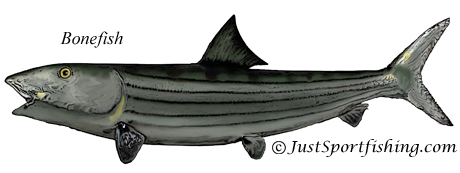|
Home Game Fish Fishing Knots Tackle Tips Videos Pictures Tips Rods & Reels Boats Cook your Catch Articles About Contact |
|
Donate to JustSportfishing.com and help to build the largest fishing information site on the web. Even a dollar or two will keep us building this free site. |
Bonefish World
Record
~ 19 Lbs. At Zululand, South
Africa on May 26, 1962 by angler Brian W. Batchelor Scientific
name
~ Albula Vulpes Other
names ~ Banana, Bananafish,
Indo-Pacific Bonefish, Ladyfish, Round Jaw, Salmon Peel, Tarpon, Tenny,
Tenpounder, Ladyfish, Silver Streak, Phantom Silver Ghost, Grubber,
White Fox Identification
~ Bonefish appear
blue-greenish above, with bright silver armor plates (Bonefish have
plates rather than scales) on the sides and belly. Dark streaks run in
between the rows of plates, predominantly on the dorsal side of the
body. The dorsal and caudal fins have dusky margins. Bonefish have
deeply forked tails. Bonefish have no spines. One of the most
distinctive characteristics of the bonefish is the sucker type mouth and
cone shaped head and snout. Size
~ In the Caribbean Sea and western Atlantic Ocean, the bonefish can
reach a length of about 30 inches and a weight of 14 pounds. In Florida
and the Bahamas fish from 2 to 5 pounds are common, with some fish
reaching 10 pounds. However, bonefish taken from Africa and Hawaii may
attain weights over 20 pounds. Habitat
~ Bonefish inhabit tropical and warm temperate waters worldwide, but are
most common in south Florida, the Bahamas, and Bermuda. On the eastern
Pacific coast, the Bonefish is found from San Francisco Bay, California,
south to Peru and west to Hawaii. Bonefish are found in schools,
sometimes in groups of up to 100 individuals, but large adult Bonefish
are solitary. Bonefish are predominately a coastal species, commonly
found in inter-tidal flats, mangrove areas, river mouths, and deeper
adjacent waters. The flats vary in composition from sand or grass to
rocky substrates. Anglers have found that Bonefish move to shallow water
during the rising tide, and a retreat into deeper water during a falling
tide. In the summer months, larger Bonefish tend to remain in deep
water, rarely moving onto the flats; they reappear in autumn. Feeding
Habits
~ Bone fish can often be seen with their tails sticking out of the water
while feeding as they swim head down stirring up the bottom looking for
prey. The Bonefish feeds on crabs, shrimp, clams, shellfish, sea worms,
sea urchins, and small fish.
|


